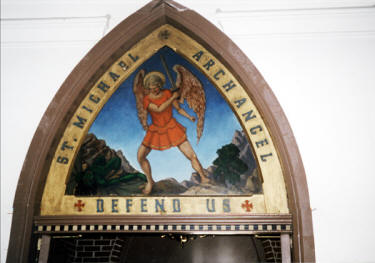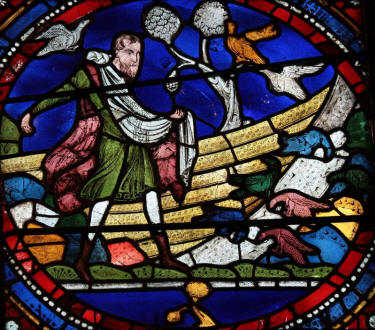A Brief History
Grace Church is one of the oldest places of worship in Hartford. It was consecrated on the feast of Saint Martin, November 11, 1868, by the Right Reverend John Williams, fourth Bishop of the Diocese of Connecticut. The parish began in the early 1860’s as a Sunday school on Baker Road (now New Park Avenue) in Parkville, under the care of Trinity Church, Sigourney Street. It was organized as Trinity Mission in 1863, and remained a chapel of Trinity Church until 1912, when it became an independent parish with the encouragement of the Reverend Ernest de Fremery Miel, then rector of Trinity.
Since that time there have been nine rectors:
Frederick J. K. Alexander, 1913–1920
Paul Humphrey Barbour, 1920–1923
Frederick F.H. Nason, 1923–1951
Robert F. Sweetser, 1951–1954
Nelson L. Chowenhill, 1954–1970
Bruce Stewart Chamberlain, 1971–1981
Christopher Lee Rose 1982–2002
[Charles Bevan, Jr. (Interim) 2002–2004]
Richard Anderson Maxwell 2004–2015
Rowena J. Kemp 2019–present
Early in the ministry of Father Nason, Grace Church became Anglo-Catholic, with masses celebrated twice on Sunday and almost every day of the week, the Reserved Sacrament, Benediction, full observance of Lent including Stations of the Cross, and observance of saints’ days and all other festival occasions.
Originally the congregation lived almost entirely in the then suburban neighborhood, and walked to church. During the last fifty years the parish’s style of worship and piety has attracted attendance from the whole Hartford metropolitan area, and visitors from many distant places.
A Guided Tour
The original church building, a chapel of Trinity Church, measured 50’x 22′ and was built through the generosity of the Reverend Francis Goodwin, a rector of Trinity and his mother, and other members of Trinity Parish. It included the central part of the present church, and had a small porch and a belfry facing New Park Avenue. It was heated by a stove and lighted by oil-burning chandeliers, and had a small organ like a parlor melodeon. In 1908-1909 an addition of ten feet was built at the front, and the parish house was enlarged. In 1966-1967 an extensive building program lengthened the nave to include the present organ and choir loft, enlarged the sanctuary, added the chapel of Our Lady of Walsingham (rededicated, with the installation of a new icon, to St. Martin, our patron saint on November 12, 2006) on the north side, and moved the entrance and the bell to a tower on the south side. At that time the present organ was installed. In 1997 Grace Church added a major new wing to its parish house to accommodate its growing food pantry and to provide new office space.
Let us enter the vestibule and discover how the church has been enriched by many symbols of Christian history and doctrine.
Entrance and Belfry
The holy water font at the right, a reminder of our baptism, was given in memory of the Reverend Nelson L. Chowenhill. Nearby hang the ringing and tolling ropes for the bell, which is inscribed in memory of Ellen W. Watkinson (1826-1874) and was cast by the famous Meneely Bell Company of Troy, New York. Restoration work on the bell and bell mechanism was completed in 1999.
Just inside the entrance to the nave, on the right, a wooden tablet bears brass plates inscribed with the names of parishioners whose ashes have been interred near the flower garden along the church’s south wall. Above the door is a mural of Saint Michael the Archangel, guardian against evil, painted by Dr.William W. Wright, a long-time parishioner, in memory of Maxwell W. Hibbert. (1887-1931); restored by F. Paul Kline in 2007.

Windows in the Nave
Upon entering the nave, we are impressed by the colorful glow poured into the church from the eight Gothic lancet windows. These were painted many years ago by Dr. Wright, and display numerous symbols of Christian history and doctrine. On the north side, near the organ, King David with his harp pictures the tradition of sacred music. Next comes Our Lady of Walsingham, reminding one of the Virgin Mary as Mother of Our Lord. Next we see the Reverend John Mason Neale, English priest and hymnodist, who translated from Greek and Latin many hymns sung in our churches. The majesty of Christ the King is next described by many symbols, and finally comes Christ the good Shepherd cradling a lamb in his arm.
On the south side, beginning at the pulpit, Saint Paul reminds us of the importance of proclaiming the Gospel to the world. Then come the symbols of the Passion and the Crucifixion, and finally the figure of the Reverend James O.S. Huntington, founder of the Order of the Holy Cross, recalling the revival of monasticism in the American branch of the Anglican Church. Members of the order have conducted many missions in Grace Church.
Baptismal Font, Stations of the Cross and Rood Beam
Scattered among the windows are fourteen Stations of the Cross, wood carvings from Oberammergau, Germany, the site of the famous passion play. They were given by Mr. Wilbur Hart.
The baptismal font at the back of the nave was given in memory of Mary Watkinson Barbour (1884-1885). Beside it stands the Paschal Candle, burned during the Easter Season and reminding us that Easter Even was the ancient time for baptism, a resurrection from darkness to light. Originally the font stood in the small chapel but was moved into the main church because baptisms are now celebrated as part of the Sunday mass, not just as family events, but as occasions for the whole congregation to share in commitment to Christ and to nurturing new life in the church.
A polychrome Calvary depicting the Crucifixion of Our Lord, witnessed by his Holy Mother and Saint John, the Beloved Disciple was made by the New York artist, Robert Robbins, and has been restored to stand atop a new rood beam dividing the sanctuary from the nave. (“Rood” is an ancient name for the cross, the “Tree of Salvation,” supposedly descended from the tree in the Garden of Eden from which Eve, the Mother of Mankind, plucked the fruit of the knowledge of good and evil. Man’s fall from grace and his salvation both came from a “tree.”)
The Chapel
On the Epistle side of the sanctuary are the chapel and altar rededicated on November 12, 2006 to St. Martin our patron saint with the installation of a new icon. [The chapel was formerly dedicated to Our Lady of Walsingham, whose shrine in England has welcomed innumerable pilgrims for centuries.]
The Ascending Christus above the chapel altar, a memorial of the Reverend Nelson L. Chowenhill, symbolizes Christ’s Ascension into Heaven. His outstretched arms express his invitation to the world: COME UNTO ME. The figure reminds us that Christ reigns and awaits us, redeemed in Heaven.
One of the chapel windows depicts the Sacrament of Baptism as conferred upon Jesus by John the Baptist. The other symbolizes the Sacrament of Confirmation, when the baptismal vows are renewed. Both were given in memory of Wilbur George Hart, who served the parish as an acolyte.
Our Lady
At the right of the chapel entrance stands a statue of Our Lady of Grace, in memory of Eliza Witter Wright (1865-1933). “Grace” as the name of a church probably was derived from “Our Lady of Grace.” The nearby vigil light stand and kneeler are memorials to Valerie Dane.
The High Altar
We are now standing in front of the focal point of the church, the high altar, with its inscription in gold letters proclaiming the origin of the Eucharist in Christ’s sacrifice of himself: I AM THE LIVING BREAD OUT OF HEAVEN. The front is carved in “linen-fold” design, suggesting the fair linen used in celebrating the Holy Communion, also the linen cloth wrappings of Christ’s burial. In the panels are symbols of the Blessed Sacrament. This altar commemorates the Reverend John Humphrey Barbour, vicar of the chapel, 1873-1889.
Behind the altar stands the Tabernacle, housing the Reserved Sacrament, for communion of the sick and for meditation upon Christ’s body as a holy sacrifice. The three Gothic lancet windows (in memory of George F. Goodman, 1848-1868) date from about 1870 and depict symbols of the Christian faith. In the central window Christ sits at the Last Supper, and above him are his cross of passion and his crown as king. In the flanking windows appear the Greek letters Alpha and Omega, signifying God as first and last; the baptismal font and the anchor of hope; the open Bible symbolizing the Word of God; and the monogram IHS, the first three Greek letters of the name Jesus, sometimes interpreted as ” Jesus, savior of Men,” in Latin Jesus Hominum Salvator.
The Flowers of Grace
Among the many blessings offered in this historic, small, Anglo Catholic Hartford landmark ~ along with liturgy, classical music, rich tradition, food for its neighborhood’s hungry, pastoral care, and spirited fellowship ~ is a special ministry of fresh flowers.
The ministry is not just the beauty and loveliness of regional blossoms obtained weekly, but their arrangement, design and placement, reflecting the gifts of devoted guilds of artisans who have worked the glows of New England and church festival seasons for more than 100 years.
A delicate style with joyful flair is my memory of Yvonne Chowenhill, a daughter of Paris who came to Grace as the wife of Nelson, its fifth rector. Her elegant displays could lighten any darkness.
James Ball shared a shortened life and career as a Connecticut florist with this parish family. He delighted in the bold and the flourish of young bushes and trees, and the special God-given glory of candle light on rose petals.
I learned from them and from an unforgettable January week in 2003 spent with a crew of flower masters at the Washington National Cathedral entitled “Flower Arranging for Holy Spaces.”
And earlier this month, May was welcomed by a most glorious salute of Dogwood on the church’s front lawn. I remember when we planted those three young trees, dedicated to the glory of God and in loving memory of so many ministers of the flowers of Grace.
Thanks be to God . . . Alleluia! Alleluia! Alleluia!
Charles F.J. Morse
May, 2016
(Edited to add newest Rector)
We have completed our pilgrimage around this historic little church. Everything we have seen expresses the purpose of Grace Parish’s ministry: the proclamation of the Word of God and the Gospel of Christ as revealed in the Bible, and the administration of the Sacraments instituted by Our Lord and hallowed by centuries of his Church’s ministry to the world.
